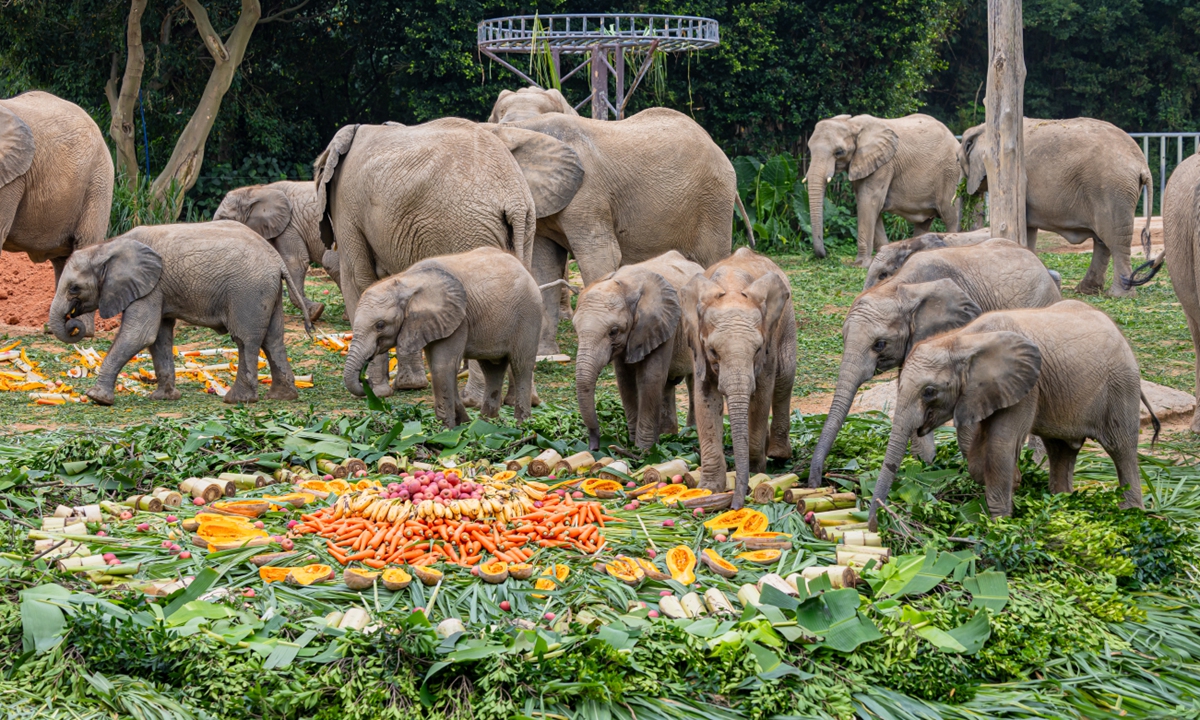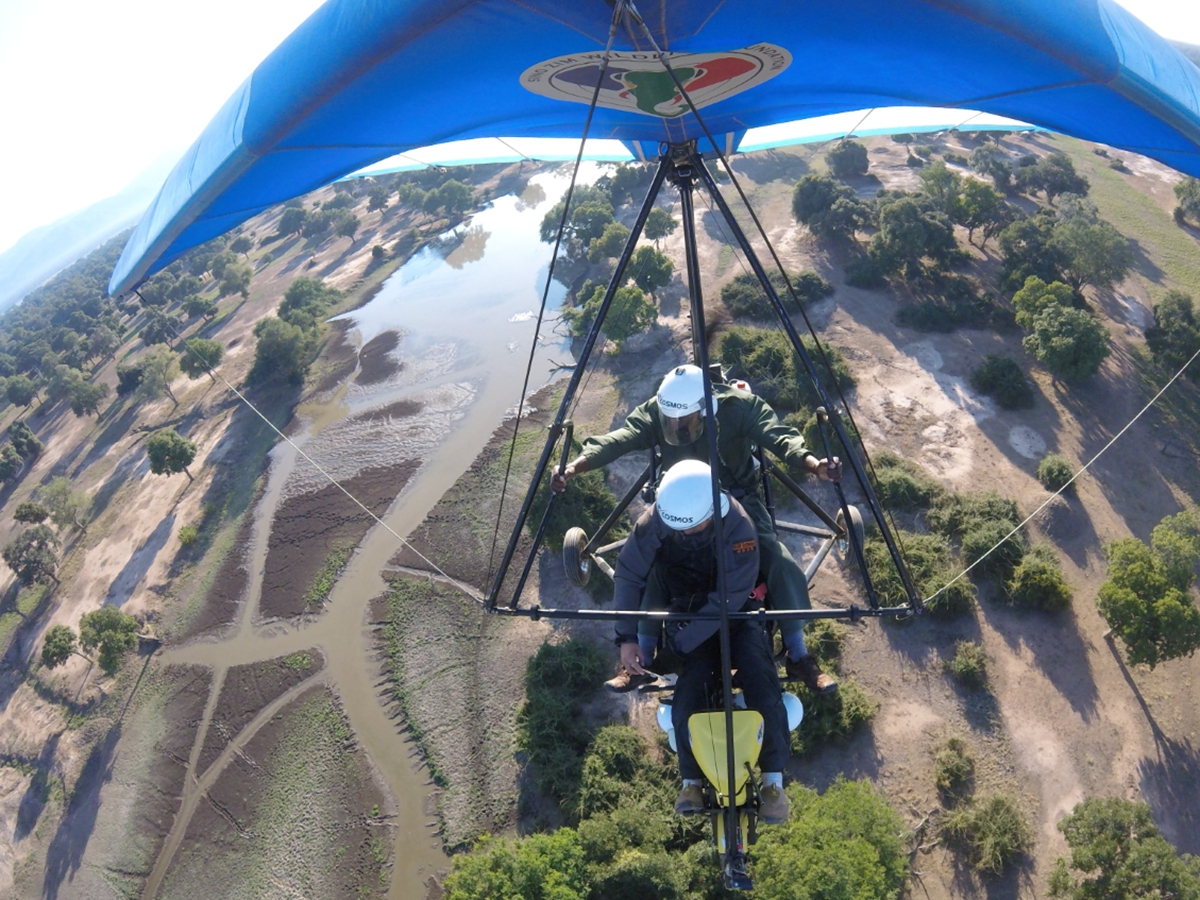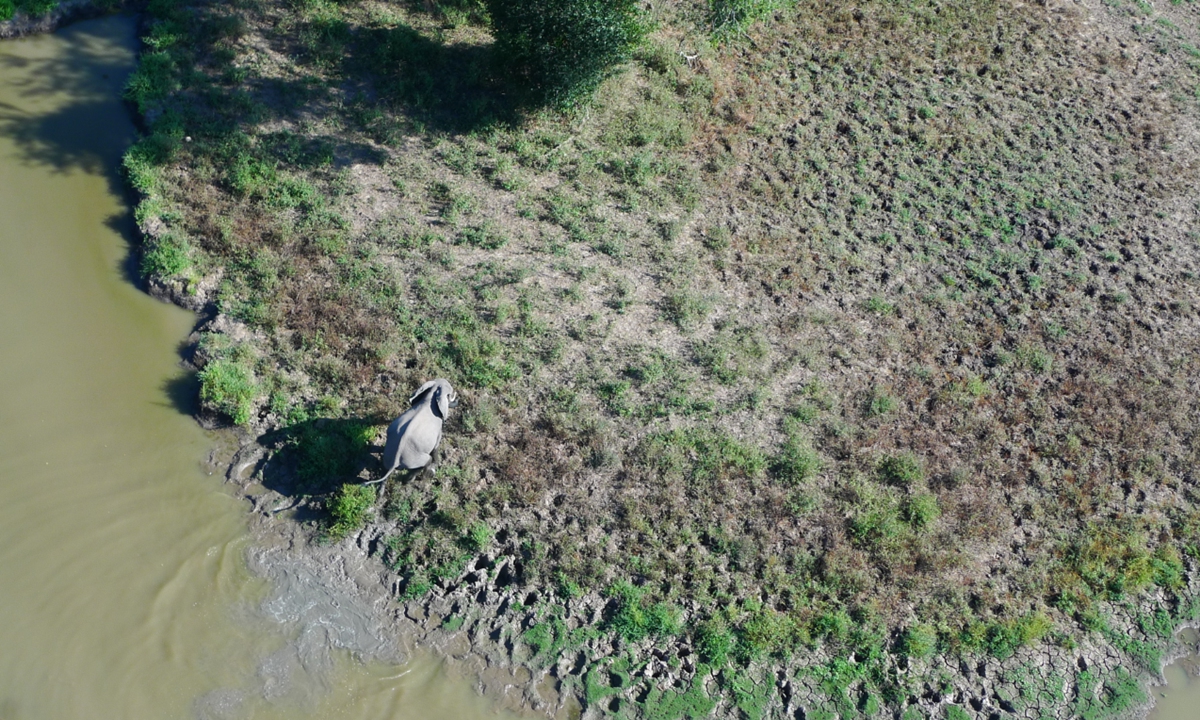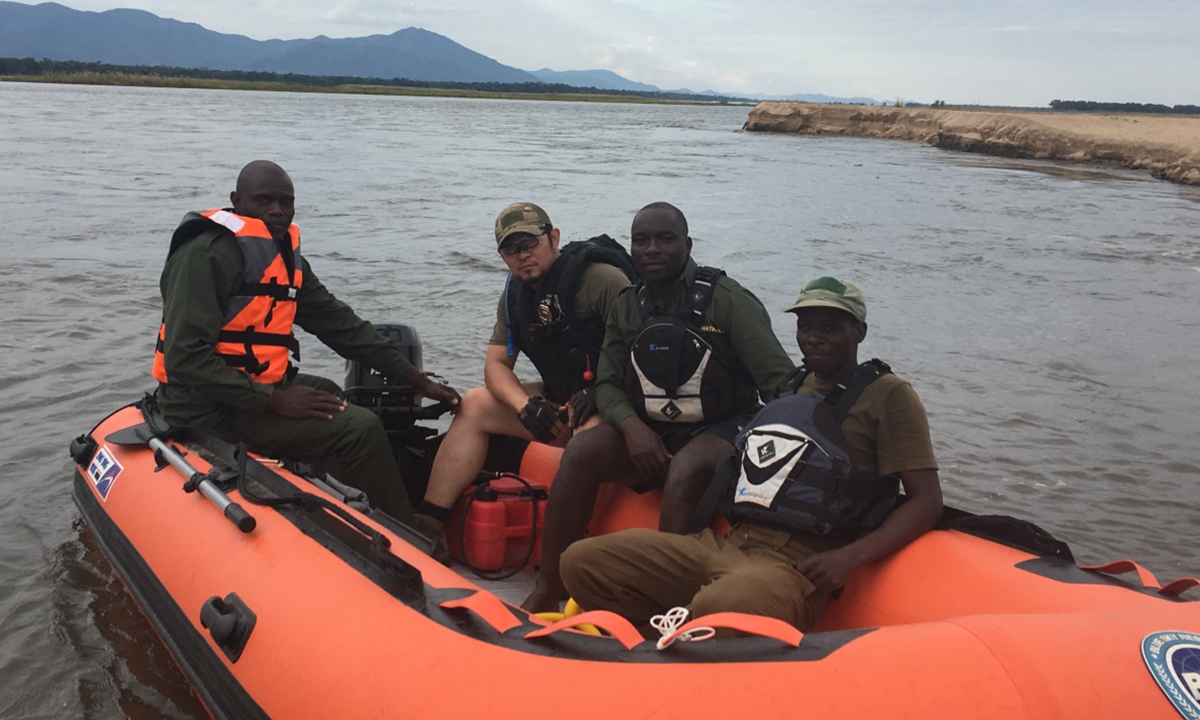
The African elephants at the Qingyuan National Ex-situ Conservation Base of World Endangered Flora and Fauna in Qingyuan, Guangdong Province. Photo: Courtesy of the conservation base
Editor's Note:
In 2013, Chinese President Xi Jinping for the first time raised the principles of "zhen shi qin cheng" for China's Africa policy in a speech at the Julius Nyerere International Convention Center in Tanzania, meaning sincerity, real results, amity and good faith.
Many years have passed since that momentous day in the history of China-Africa ties, but the principles endure. They have not only underpinned China's engagement with Africa in numerous fruitful cooperation projects, but also helped people get closer and closer through exchanges and deepening friendships.
From wild elephants to rare plants, China and Africa have been working together to maintain the world's biodiversity, contributing to the world with their solutions and experience. In this issue of the special coverage of the 2024 Summit of the Forum on China-Africa Cooperation (FOCAC), Global Times reporters Ji Yuqiao, Dong Feng and Xu Liuliu introduce more details of this cooperation and joint efforts.

A Chinese volunteer takes a powered delta wing on a patrol with a local ranger in Zimbabwe. Photo: Courtesy of Bu Guijun
The size of the African elephant is something that profoundly impressed Bu Guijun when he engaged in anti-poaching efforts in Zimbabwe.
"Did you know African elephants can walk without making any sound? Once while we were focused on testing our equipment, we suddenly felt something unusual behind us, and then turned around with terrified faces as the giant creature, around five meters tall, stood just two to three meters away from us," he recalled in the interview with the Global Times.
After taking part in the efforts, Bu also became more keenly aware of the survival dilemma the largest terrestrial mammal faces.
"Before 2017, there were at least 1,000 elephants killed by poaching just in Zimbabwe," Bu said. At that time, due to limited equipment and manpower, local park rangers had to spend a large amount of time patrolling around the 2,900-square-kilometer Mana Pools National Park, which had only a minimal deterrent effect on the crimes committed against the wild animals.
Since 2015, dozens of Chinese volunteers, organized by the Beijing-based non-profit organization Peaceland Foundation and furnished with advanced equipment such as delta wings and night-vision devices, lent a hand to the national park to protect these creatures from the threat of poachers. Bu was one of them.
Four years later, poaching in the national park was virtually eliminated.
Also in 2015, more than 20 abandoned African elephant calves were rescued and brought to China through the joint efforts of relevant authorities in China and Zimbabwe. They have been settled at the Qingyuan National Ex-situ Conservation Base of World Endangered Flora and Fauna in South China's Guangdong Province.
Chinese breeders built a home suitable for the elephants' growth according to expertise on the species' habitual nature. The first of the second generation of these special "immigrants" was born in 2022, and by August 2024, a total of 10 baby elephants have been born at the base. The family is thriving.
Be it on the vast African savanna or at the breeding grounds in South China, the population of African elephants has been regaining vitality through Chinese cooperation with African countries. This return mirrors the current situation of other species on the African continent.
An initiative to strengthen China-Africa cooperation for green and sustainable development was launched in Beijing on August 27 before the 2024 Summit of the Forum on China-Africa Cooperation (FOCAC) with the aim of sharing the best practices in areas such as climate change mitigation and adaptation, biodiversity conservation, and environmental pollution management. Additionally, the initiative facilitates collaboration in standards and technologies.
Before that, a series of efforts aimed at environmental and biodiversity issues had been launched. For instance, the China-Africa Environmental Cooperation Center, a platform for broad environmental policy dialogue, information exchange, capacity building and cooperation on green development, was officially established at the 7th Forum on China-Africa Cooperation Summit held in 2018.
Experts pointed out that China and Africa are enhancing collaboration in the burgeoning area of biodiversity preservation.
"This partnership can be seen as a model for how countries can work together to address global environmental challenges. By sharing resources, knowledge, and expertise, China and Africa can enhance their capacity to protect endangered species and ecosystems," Edward Mungai, chief editor of Africa Sustainability Matters based in Kenya, told the Global Times.

An African elephant at the Mana Pools National Park of Zimbabwe Photo: Courtesy of Bu Guijun
Population reboundAll 10 elephant calves have survived and are in a healthy state since the first was born in 2022, the Chinese breeding base told the Global Times in a statement, emphasizing that "All baby elephants are raised by their mothers. As these are orphaned elephants, which did not receive any instruction on survival and nurturing from the elephant herd, them being able to raise their own young can be seen as a miracle."
Now, even the two youngest elephants are gaining one to 1.2 kilograms in weight per day.
To maintain the herd's health and capability to reproduce, Chinese breeders spent lots of time searching for a suitable environment for the elephants to live in. They also hired people to plant 300 acres of elephant grass and other varieties of trees in the mountains as food for the herd.
"In the beginning, we already had experience taking care of Asian elephants, which helped us take care of these young African elephants. At present, the African elephants have their own healthy menu for their diet, and breeders have established a firm rapport with the herd by caring about their mental state at the same time," the statement said.
As the African elephant herds' needs change across different stages of their lives, the base is mulling whether it will be best to send these elephants back to their homeland that would be more suitable for them.
"This progress highlights the potential of ex-situ conservation, where species are maintained and bred outside their natural habitats. The successful breeding of 10 baby elephants is evidence of the effective management and care provided at the center. It demonstrates how human intervention, when properly executed, can contribute positively to the survival and propagation of species at risk of extinction," Mungai commented.
The success at the breeding base highlights the potential for further collaboration in other areas of biodiversity conservation, such as the protection of other endangered species, habitat restoration, and the development of sustainable wildlife management practices, Mungai explained.
Data from international organizations also indicate that some progress has been made in efforts to preserve biodiversity in Africa.
With joint efforts, mountain gorillas are also making a comeback. The species based in Virunga Massif, an area of about 450 square kilometers straddling the Democratic Republic of the Congo, Rwanda and Uganda, saw an increase in numbers, which jumped from 620 individuals in 1998 to 1,063 today.
The African rhino population has also been growing. Ahead of World Rhino Day in September 2023, African authorities estimated that there were 23,290 rhinos across the continent at the end of 2022, 5.2 percent more than in 2021.
Experts emphasized that there is plenty of room for China-Africa cooperation on biodiversity conservation to further increase the population of these endangered species.
Song Wei, a professor at the School of International Relations and Diplomacy, Beijing Foreign Studies University, highlighted China's active role in its commitment to the international convention on biodiversity. China was among the first to sign the Convention on Biological Diversity (CBD), considered to be the key document for supporting global sustainable development.

Bu Guijun (second from left) and local rangers use inflatable boats for water patrols in Zimbabwe. Photo: Courtesy of Bu Guijun
Chasing hope In recent years, the Chinese government has reinforced wildlife protection laws, launched major biodiversity conservation projects, banned the trade of ivory, and taken a strong stance against the illegal trade of wildlife products like elephant and rhino parts. China has also been proactive in international wildlife protection cooperation, signing agreements with African nations such as South Africa and Kenya.
Furthermore, China has supplied container monitoring systems and wildlife protection gear to countries like Tanzania, Zimbabwe, and Botswana, while also assisting in training efforts. This support has significantly boosted these African countries' law enforcement capabilities and efforts to protect their wildlife.
All of these endeavors aim to create a safer and more suitable environment for wildlife so as to maintain their population.
Without the threat of poachers, the African elephants living at the Mana Pools National Park have been flourishing.
What contributed to this result is the sea-land-air three-dimensional protection model jointly established by local patrolmen and Chinese volunteers like Bu.
Bu told the Global Times that the volunteers recognize the idea that rather than giving someone a fish, it is better to teach them to fish, so they sent various tools for patrolling, including gliders, delta wings and speed boats designed for shallow water territory to the park, aiming to enlarge patrolling areas and enhance efficiency.
Chinese volunteers worked hand in glove with local rangers almost every day and took part in patrols with these rangers. During this process, they tried to teach rangers to use various advanced equipment such as night-vision devices and thermal cameras.
"At the beginning, local people queried whether we sincerely wanted to help them fight poachers, but time has proven our commitment. After taking helicopters, boats and vehicles together on patrols and sharing our food with each other, we became friends," Bu said.
Even today, Chinese volunteers back home remain in touch with the African rangers. "They still look forward to us visiting the park," Bu said.
Even though volunteers have left the national park, the foundation still delivers supplies such as hay to support the conservation efforts.
There have been some institutions concentrating on talent cultivation and scientific research, including the Sino-Africa Joint Research Center approved by Chinese Academy of Sciences. Based at the Jomo Kenyatta University of Agriculture and Technology of Kenya, the center has built long-term cooperative relationships with over 20 universities and scientific research institutions in more than 10 countries in Africa. Meanwhile, it has provided scholarships to more than 140 students from Africa to pursue master's or PhD degrees while over 160 scientists and senior technicians from 13 African countries have also been trained since the inception of the center.
"China has been regulating Chinese enterprises in their investment and operations in Africa. Take protecting local biodiversity for instance. While building the Mombasa-Nairobi Standard Gauge Railway [SGR], Chinese organizations attached great importance to ensuring the migration of animals was not affected," Song added.
Sharing her outlook on China, a responsible major country, Song said that the Chinese government will continue to regulate Chinese organizations to protect biodiversity and promote green development.
She also foresees that China will continue its commitment under the framework of the UN and its support for the CBD as well as provide necessary development funds for the international convention.
"China will work with developing countries to improve their capabilities in biodiversity protection, raise awareness among the people and offer financial and technical support," said Song.







